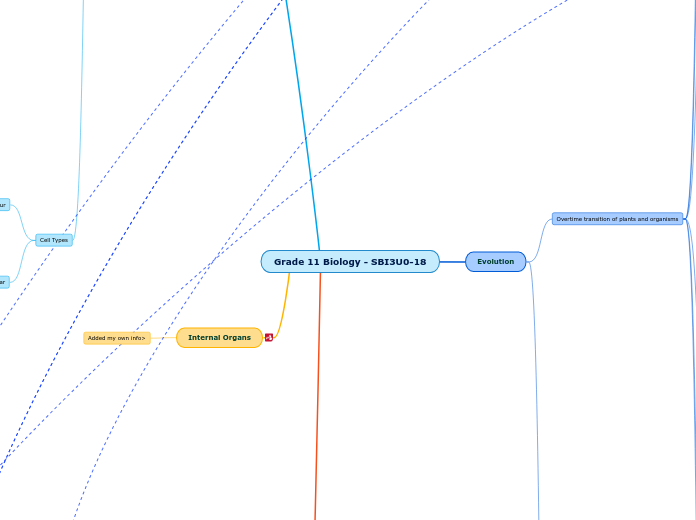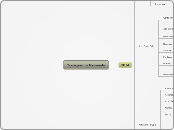Grade 11 Biology - SBI3U0-18
Genetics - The study of Heredity
Gene Crosses
Monohybird
Creating a cross about one trait for 2 biotic structures
4 by 4 punnet square for traits
Dihybrid
Creating a cross about 2 trait for 2 biotic structures
16 by 16 punnet square for traits
Cell Cycle
Overview of Cells
Living Organisms
Animal
Plant
Theory
Evolved from cells existing before
All biotic are made of of cells, one or many
Why?
Remainder of the cycle: Interphase
Replicating DNA, AKA S Stage
Pre division, AKA G2
Growth of Cell, AKA G1
To develop, repair, and reproduce
Blood
Divided into different groups depending on antigen
Any type O does not
A and B have antigen
Identical Diploids
Results in Mitosis
Mendel, Gregor
Monk (scientist) who studied peas in the 1800's
created the genetic base
His knowledge gained
Investigation of how genes are passed
Segregation Rule
Allele different, separatepic
Inheritance
Independent Assortment
Irregular
Combine
Adapt
Meiosis
Procedure
Mitosis takes place second time
First one
Detach homologous pairs
Second Part
Detach Sister Chromatids
Final Cytokinesis
Telophase (II)
Anaphase (II)
Metaphase (II)
Prophase (II)
Cytokinesis
Cell Divides into 2 daughter cells
Telophase
Fibres separate chromosomes
Anaphase
Spindle fibres attach
Metaphase
Chromosomes line up in the middle
Prophase
Chromosomes are present and less dense
Creates 4 cells which are Haploid
Gametes development (2 haploids = diploids)
Sper and Egg makes a Zygote
2 Haploid
X,X is the female egg
Increase in ecosystem survival rate due to
Genes / Phenotype Variations
Example: Not everyone dies from the same sickness.
Patterns of inheritation
Genetic Variation
What is behind this?
Recombination in genes
Homologous chromosomes interact with one another.
Genetic content interchange
May result in cancer
Diseases that replicate cells aberrantly and transmit
What does cancer mean?
The outcome of DNA copying errors made during cell division
Non-disjuncture
Known as aneuploidy, not normal amount of chromosomes in the cell
Mistakes in Chromosomes
Segregation Rule ( for mono)
Allele and Genotypes
Lowercase is recessive and dominate is uppercase
Heterozygous
Two independent alleles for one gene
(one dominant and one recessive allele, respectively)
Homozygous
Two of the same alleles with one gene
(either predominant or both recessive)
Diseases in Genes
Linked to gender
Most often in men
Autosome Chromosome (non ses chromosome)
Reccesive
Dominant
Co dominant
Mixed
Not complete dominant
blended
Internal Organs
Added my own info>
Biodiversity
Cell Types
Multicellular
Eukaryotic
Contain cell membrane
Fungi, Plantea, protisits, anamillia
Many cells
Uncellilur
uncellular
One cell
Overall 6 kingdoms
Eubacteria
Aquatic/Inside Bodies
In extreme conditions
Prokaryotic
Colonisation in harsh conditions.
Have lipids
very small
Prokaryotes
No nuclei
Plantae
Photosynthesis (make own food
Have cell wall
Not Mobile
Protista
Give ood, shelter, and oxygen for numerous underwater ecosystems.
Multi cellular
Animalia
Cell walls are not there
Reproduce
Eukaryotes
Heterotrophic
Always moving around
Require Oxygen
Fungi
Characteristics
They replicate by spores
No embryonic stage.
Non-vascular organisms
Fungi are eukaryotic cells, which means that they have a real nucleus embedded in membranes.
Linnean Classification System
Who is behind it?
Carl Linnaeeus (scientist from Swedan, 1700's
Creating Binomial Nomenclature
He is the one who organized the linnean system
Kingdoms
Reason
There are way to many organisms and species and this is very effective
3 Classifying Subcategories
Archea
Any other bacteria that isn't in the realm of Archaea are considered.
Bacteria
The oldest recognised world of ancient bacterial forms.
Eukarya
Both species that are eukaryotic that contain organelles and nuclei that are membrane-bound.
What is it?
Scientific method of naming species into categories
Hence, different groups are created for the million species
Domain
"Life on Earth diversity and variability"
Makes this
Deforestation
Climate: Global Warming
Habitat change
Pollution
These impact the environment
Migration of Species
Extinction of Species
Economy can be effected
Class Mindmap
Evolution
Charles Darwin and the theory for Evolution
Charles Darwin- Born in 1809 in England, Naturalist, geologist and biologist
Variation: Tiny variations in the population
And is inherited
Competition for selective preasure
Higher fitness species survive longer
Change of species over time
Overtime transition of plants and organisms
Comparative Anatomics
Build of different organisms
Homologous
The structure is same but functions are different
Vestigial
From Evolved
Various ecosystems
Similarities
Identical Feature
Different Composition
Speciation
Allopatric speciation
Sympatric Speciation
Various Routes
Adaptation takes place to counteract the adaptation of other species.
(prey verses predator)
Barriers in Reproducing
There are 2 kind
Prezygotic
Temporal Isolation
Behavioural Isolation
Genetic Isolation
Mechanical Isolation
Habitat Isolation
Post Zygotic
Hybrid Sterility
Hybrid Inviability AKA ^
Hybrid Breakdown
Subtopic
Post-Reproduction
Mechanisms involved in evolution
Macroevolution
Over long periods of time, developmental shifts
The root of new groups is and includes
Genetic Drift
Random alterations in genetic variation
Because of an opening
Bottle neck effect
Founder Effect
Inbreeeding
Near individuals who are related
Bred for each other
gene
Allelele migration from one population
Through still.
Planned Mating
Individuals are breeding with
Others of particular phenotypes
Microevolution
Alterations of the gene pool
a single population
Reproductive Barriers
Choices of Traits
Outlets for variation
Mating which isn't random
Bred for particular phenotypes with others
Recombination
Build new frequencies with alleles,
the introduction of new alleles by means of
Mutations
Introducing new alleles spontaneously
From one gene to another
Sources of organism variance mechanism Adaptation
Shifting and evolving
Natural Selection
Favoured by environment
Certain allels fitness increases
Stable selection
Selected Artificially
Non random, selected by species like humans
Interbred those with characteristics required (Phenotype)









